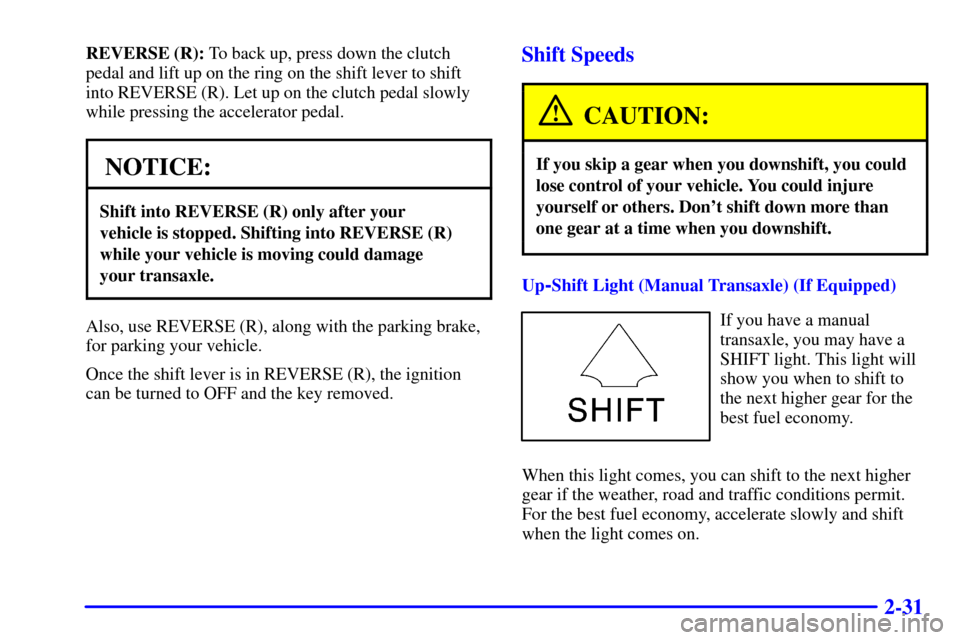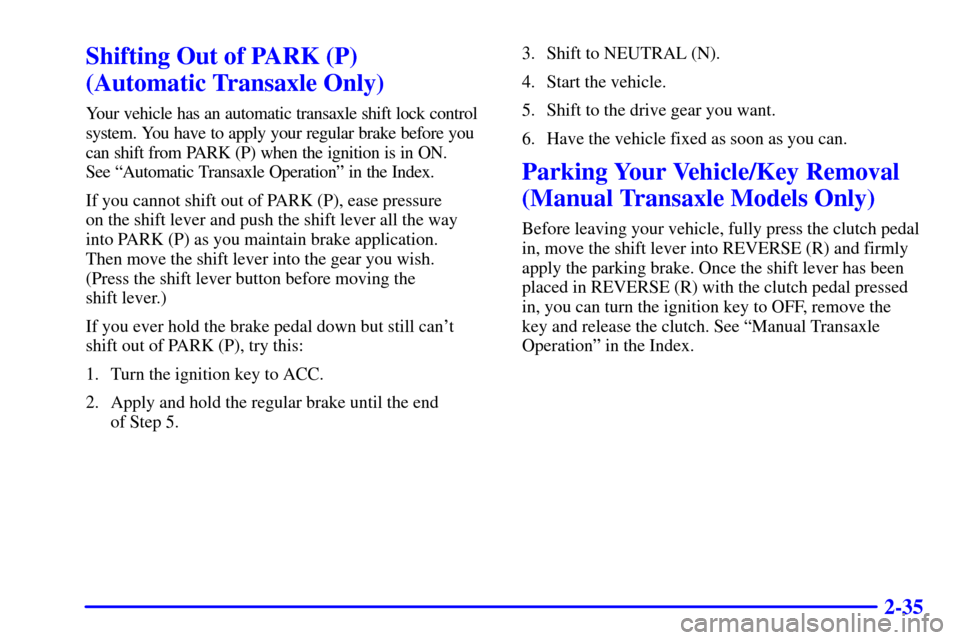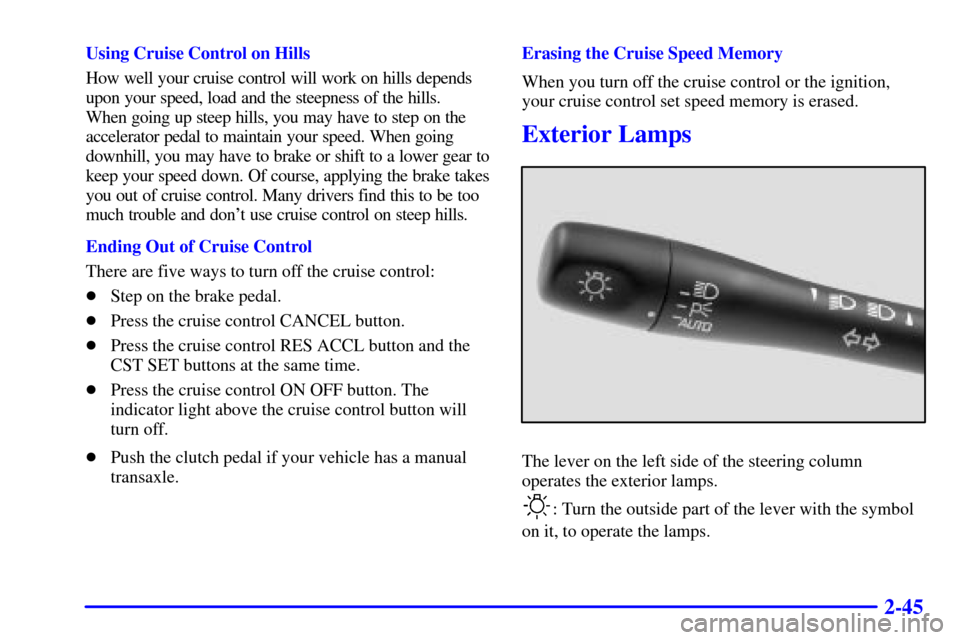Page 93 of 343

2-31
REVERSE (R): To back up, press down the clutch
pedal and lift up on the ring on the shift lever to shift
into REVERSE (R). Let up on the clutch pedal slowly
while pressing the accelerator pedal.
NOTICE:
Shift into REVERSE (R) only after your
vehicle is stopped. Shifting into REVERSE (R)
while your vehicle is moving could damage
your transaxle.
Also, use REVERSE (R), along with the parking brake,
for parking your vehicle.
Once the shift lever is in REVERSE (R), the ignition
can be turned to OFF and the key removed.
Shift Speeds
CAUTION:
If you skip a gear when you downshift, you could
lose control of your vehicle. You could injure
yourself or others. Don't shift down more than
one gear at a time when you downshift.
Up-Shift Light (Manual Transaxle) (If Equipped)
If you have a manual
transaxle, you may have a
SHIFT light. This light will
show you when to shift to
the next higher gear for the
best fuel economy.
When this light comes, you can shift to the next higher
gear if the weather, road and traffic conditions permit.
For the best fuel economy, accelerate slowly and shift
when the light comes on.
Page 94 of 343
2-32
Parking Brake
Automatic Transaxle shown,
Manual Transaxle similar
To set the parking brake, pull up on the parking brake
handle. If the ignition is on, the brake system warning
light will come on.To release the parking brake, hold the regular brake
pedal down. Pull the parking brake handle up until you
can press the release button. Hold the release button in
as you move the brake handle all the way down.
NOTICE:
Driving with the parking brake on can cause
your rear brakes to overheat. You may have to
replace them, and you could also damage other
parts of your vehicle.
If you are towing a trailer and are parking on a hill, see
ªTowing a Trailerº in the Index. That section shows
what to do first to keep the trailer from moving.
Page 95 of 343
2-33
Shifting Into PARK (P)
(Automatic Transaxle Only)
CAUTION:
It can be dangerous to get out of your vehicle if
the shift lever is not fully in PARK (P) with the
parking brake firmly set. Your vehicle can roll.
If you have left the engine running, the vehicle
can move suddenly. You or others could be
injured. To be sure your vehicle won't move,
even when you're on fairly level ground, use
the steps that follow. If you're pulling a trailer,
see ªTowing a Trailerº in the Index.
1. Hold the brake pedal down with your right foot and
set the parking brake.2. Move the shift lever into PARK (P) like this:
Automatic Transaxle shown,
Manual Transaxle similar
�Hold in the button on the shift lever.
�Push the shift lever all the way toward the front
of the vehicle.
3. Turn the ignition key to OFF.
4. Remove the key and take it with you. If you can
leave your vehicle with the ignition key in your
hand, your vehicle is in PARK (P).
Page 97 of 343

2-35
Shifting Out of PARK (P)
(Automatic Transaxle Only)
Your vehicle has an automatic transaxle shift lock control
system. You have to apply your regular brake before you
can shift from PARK (P) when the ignition is in ON.
See ªAutomatic Transaxle Operationº in the Index.
If you cannot shift out of PARK (P), ease pressure
on the shift lever and push the shift lever all the way
into PARK (P) as you maintain brake application.
Then move the shift lever into the gear you wish.
(Press the shift lever button before moving the
shift lever.)
If you ever hold the brake pedal down but still can't
shift out of PARK (P), try this:
1. Turn the ignition key to ACC.
2. Apply and hold the regular brake until the end
of Step 5.3. Shift to NEUTRAL (N).
4. Start the vehicle.
5. Shift to the drive gear you want.
6. Have the vehicle fixed as soon as you can.
Parking Your Vehicle/Key Removal
(Manual Transaxle Models Only)
Before leaving your vehicle, fully press the clutch pedal
in, move the shift lever into REVERSE (R) and firmly
apply the parking brake. Once the shift lever has been
placed in REVERSE (R) with the clutch pedal pressed
in, you can turn the ignition key to OFF, remove the
key and release the clutch. See ªManual Transaxle
Operationº in the Index.
Page 101 of 343

2-39 Turn and Lane-Change Signals
The turn signal has two upward (for right) and two
downward (for left) positions. These positions allow
you to signal a turn or a lane change.
To signal a turn, move the lever all the way up or
down. When the turn is finished, the lever will
return automatically.
An arrow on the instrument
panel cluster will flash in
the direction of the turn or
lane change.
To signal a lane change, just raise or lower the lever
until the arrow starts to flash. Hold it there until you
complete your lane change. The lever will return by
itself when you release it.As you signal a turn or a lane change, if the arrows
flash rapidly, a signal bulb may be burned out and
other drivers won't see your turn signal.
If a bulb is burned out, replace it to help avoid an
accident. If the arrows don't go on at all when you
signal a turn, check for burned
-out bulbs and then check
the fuse (see ªFuses and Circuit Breakersº in the Index).
Turn Signal On Chime
If your turn signal is left on for more than 3/4 of a mile
(1.2 km), a chime will sound at each flash of the turn
signal. To turn off the chime, move the turn signal lever
to the off position.
Lamps On Reminder
If you open the driver's door and turn off the
ignition while leaving the lamps on, you will hear
a warning chime.
Page 102 of 343
2-40 Headlamp High/Low-Beam Changer
To change the headlamps from low beam to high beam,
push the turn signal/multifunction lever away from you.
When the high beams are
on, a light on the instrument
panel cluster will come on
if the ignition is in ON.
To change the headlamps from high beam to low beam,
pull the turn signal lever toward you.
Flash-to-Pass
This feature lets you use your high-beam headlamps to
signal a driver in front of you that you want to pass.
To use it, pull the turn signal/multifunction lever toward
you until the high
-beam headlamps come on, then
release the lever to turn them off.
Windshield Wipers
Use this lever located on the right side of the steering
wheel to operate the windshield wipers.
OFF: Move the lever to OFF to turn off the
windshield wipers.
Page 107 of 343

2-45
Using Cruise Control on Hills
How well your cruise control will work on hills depends
upon your speed, load and the steepness of the hills.
When going up steep hills, you may have to step on the
accelerator pedal to maintain your speed. When going
downhill, you may have to brake or shift to a lower gear to
keep your speed down. Of course, applying the brake takes
you out of cruise control. Many drivers find this to be too
much trouble and don't use cruise control on steep hills.
Ending Out of Cruise Control
There are five ways to turn off the cruise control:
�Step on the brake pedal.
�Press the cruise control CANCEL button.
�Press the cruise control RES ACCL button and the
CST SET buttons at the same time.
�Press the cruise control ON OFF button. The
indicator light above the cruise control button will
turn off.
�Push the clutch pedal if your vehicle has a manual
transaxle.Erasing the Cruise Speed Memory
When you turn off the cruise control or the ignition,
your cruise control set speed memory is erased.
Exterior Lamps
The lever on the left side of the steering column
operates the exterior lamps.
: Turn the outside part of the lever with the symbol
on it, to operate the lamps.
Page 108 of 343

2-46
The exterior lamps control has three positions:
(Parking Lamps): Turning the control to this
position turns on the parking lamps, together with
the following:
�Sidemarker Lamps
�Taillamps
�License Plate Lamps
�Instrument Panel Lights
(Headlamps): Turning the control to this position
turns on the headlamps, together with the previously
listed lamps and lights.
AUTO: Turning the control to this position turns the
headlamps, taillamps and parking lamps on and off
automatically, while the ignition is on, by sensing how
dark it is outside. For more information see ªAutomatic
Light Controlº later in this section.
Daytime Running Lamps
Daytime Running Lamps (DRL) can make it easier
for others to see the front of your vehicle during the
day. DRL can be helpful in many different driving
conditions, but they can be especially helpful in the
short periods after dawn and before sunset. Fully
functional daytime running lamps are required on all
vehicles first sold in Canada.
The DRL system will make your high
-beam headlamps
come on at a reduced brightness when the following
conditions are met:
�The ignition is on,
�the exterior lamps control is in AUTO or the parking
lamps only position,
�the light sensor detects daytime light,
�the parking brake is released, and
�the shift lever is not in PARK (P) on vehicles with an
automatic transaxle only.
When the DRL system is on, the taillamps, sidemarker
lamps, parking lamps and instrument panel lights will
not be illuminated unless you have turned the exterior
lamps control to the parking lamp position.
As with any vehicle, you should turn on the regular
headlamp system when you need it.